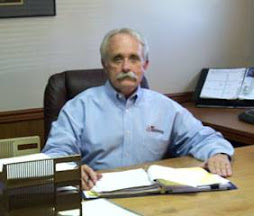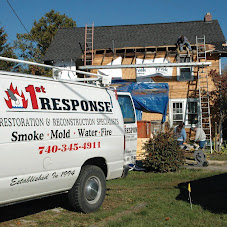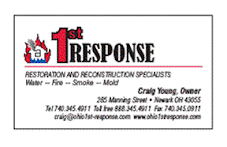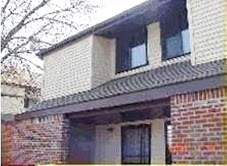Learn what to do and what not to do on water, fire and smoke damageIf you’re in the midst of a water, fire or smoke disaster, know that
1st Response will be there when you call 345-4911. In the meantime, here are some ways to mitigate the damage yourself.
What to do if you ever have water damage:If the outside temperature is above 60 degrees, use dehumidifiers if available.
Use fans to circulate the air and assist drying.
Remove as much water as possible by mopping and blotting.
Wipe furniture dry.
Lift draperies off carpet, loop through a coat hanger, and place the hanger on the drapery rod.
Prop up wet furniture cushions for even drying and place small wood blocks or aluminum foil under furniture legs.
Remove wet area rugs or other floor coverings.
Open furniture drawers, closet doors, and luggage to enhance drying.
Move photos, paintings, and art objects to a safe, dry location.
Remove wet fabrics and dry them as soon as possible. Hang furs and leather goods to dry separately at room temperature.
Remove damp books from shelves and spread out to dry.
If damage occurs during a cool season, leave heat on; if in summer, use an air conditioner if available.
Important warnings on water damage Do not use an ordinary household vacuum to remove water.
Do not use electrical appliances while on wet carpet or wet floors.
Do not go into rooms with standing water if the electricity is still on.
Do not lift tacked down carpet without professional help. Lifting the carpet incorrectly could promote shrinkage.
Do not wait to call for professional help. Damage from the water and bacteria growth can begin within hours.
What to do if you have smoke/fire damage Blow off or brush-vacuum loose soot particles from upholstery, drapes, and carpets.
Cover carpeted traffic areas with towels or old linens to prevent additional soiling.
Discard open food packages. The food could be contaminated.
If electrical service is off, clean out your freezer and refrigerator. Leave the doors propped open or place charcoal in the unit.
Send clothing with heavy smoke damage to a qualified professional dry cleaner who specializes in smoke damage.
Clean Formica and chrome fixtures in the kitchen and bathroom to prevent permanent tarnishing.
Wipe residue from porcelain bath fixtures to prevent etching.
Wipe the leaves of houseplants to remove smoke residue.
Change the air filter on your furnace if it uses forced hot air.
Tape cheesecloth over intake and outlet air registers to capture any loose soot in the air. This is even more effective if the cheesecloth is damp.
If the outside temperature is above 60 degrees, air out the house to reduce smoke odor.
Important warnings on smoke and fire damage Do not attempt to wash any papered or flat painted walls without consulting 1st Response. Incorrect cleaning procedures could compound the soot residue problem.
Do not attempt to clean carpets or upholstered furniture. Again, incorrect procedures could increase damage.
Do not use electrical appliances that have been close to fire or water before having them checked. They could malfunction.
Do not use ceiling fixtures if the ceiling is wet. A short circuit could result.
Do not touch anything. Soot on your hands can permeate upholstery, walls, and woodwork, causing further damage.
Do not eat food that has been exposed to fire or smoke.
Do not wait to call for professional help.
Call
1st Response, 345-4911.
















